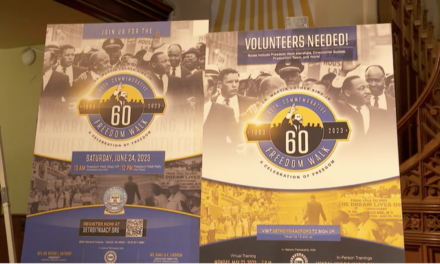As part of Detroit Public Television’s documentary “Detroit Designs the World,” we transport back to 1950’s Detroit when architect Minoru Yamasaki (1912 – 1986) began to make his mark on the Detroit skyline. Yamasaki, most known for designing the World Trade Center, was a leader in mid-century modernism that equally evoked design elements from across the globe. His designs can be seen across Detroit, from his 1927 design of the Federal Reserve Bank of Chicago Detroit Branch, to the McGregor Memorial Conference Center at Wayne State University and the One Woodward skyscraper — his first skyscraper.
Former Detroit Free Press business writer and author John Gallagher, Jeanette Pierce of the City Institute, and Dr. Dale Gyure, professor and department chair of architecture and design at Lawrence Tech University and the author of “Minoru Yamasaki: Humanist Architecture for a Modern World,” explore Yamasaki’s designs across Detroit, examine the beauty and diverse influences of his designs, and reflect on the legacy he left in the Motor City.
Full Transcript:
John Gallagher, Business Writer & Author, Detroit Free Press: We remember Yamasaki today as the designer of the World Trade Center in New York, the twin towers that unfortunately were lost on 9/11. Beyond that, he was a leader in what we call mid-century monetarism, which took the basic efficiency of modernism, glass and steel and clean lines, and kind of infused it with some warmth and beauty that we associate more with something like the arts and crafts movement. Yama, what we say softened and humanized modernism in some really important ways.
Dr. Dale Gyure, Lawrence Tech Professor of Architecture and Design, Author of ‘Minoru Yamasaki: Humanist Architecture for a Modernist World’: So many modernists had struggled for so long before the 50s to try to create and convince people of modern architecture that didn’t rely on the past, that was of the 20th century and didn’t need to use arches and other elements from the history.
Unidentified Speaker: We will succeed in creating the first modern technological, humane, prosperous civilization.
Dr. Dale Gyure: Inspired by his travels, he was incorporating sure elements of the Italian Renaissance architecture and French Gothic architecture. He was using Islamic arches, and he was using the notion of the screened window from Islamic architecture.
Dr. Dale Gyure: He used a lot of elements from Japanese architecture. So he didn’t limit himself to the Western history like some modernists tried to. He really was a pioneer global architect. The problem was that in the mid-50s, modernism was still very strong and still very influenced towards rejecting that historical past.
John Gallagher: At the end of World War Two, the Detroit firm of Smith Hinchman Grylls was looking for a new chief designer and heard about this young, Minoru Yamasaki in New York, and hired him to come to Detroit. And I think like a lot of people who come from far away from Detroit, he probably thought he would be here for a couple of years and move on. Instead, he spent the rest of his life here.
John Gallagher: Well, Yamasaki started out with Smith Hinchman doing some first of the first modernist buildings in Detroit, the Federal Reserve building in downtown Detroit that was highly praised and much imitated.
Jeanette Pierce, Founder & Executive Director, Detroit Experience Factory: As early as 1948, he was really pushing the envelope for these sleek lines and large glass windows, and the Annex is a beautiful example of that. People walk by every day and don’t even really notice that that is one of the most famous architects in the world.
John Gallagher: He got his reputation fairly quickly here. He did schools everywhere. And then he became Wayne State University’s almost in-house architect. He did their McGregor Conference Center on the campus, which is one of his very best buildings. And by that time, his reputation was growing and he started doing buildings around America and around the world.
Dr. Dale Gyure: McGregor is really, I think, in the architectural world considered to be his masterpiece. It’s the one of the first buildings he designed after his world tour, and it goes farther, I think, than any other work that he did in terms of incorporating disparate elements and disparate influences from around the world.
Dr. Dale Gyure: For instance, it has elements of a Greek temple to it, it has elements of a gothic cathedral. It has a little bit of those Islamic screens that I mentioned. Pools outside the building are very Japanese sort of atmosphere, and he kind of brings all these different ideas together.
Dr. Dale Gyure: And in the other work that he does after this, he never seems to reach out to as many different kind of influences as he did at McGregor. Plus, McGregor, I think, is just well done in terms of the details and the proportions and the relationship between the inside and the outside.
John Gallagher: In the 50s, Yama began to work on a project for the Michigan Consolidated Gas Company, which needed a new headquarters, and he created what is now known as One Woodward a skyscraper.
Dr. Dale Gyure: It was his first skyscraper. People don’t realize this, but it wasn’t even completed at the time that he was hired to do the World Trade Center, which was going to be the world’s tallest building. And here he had just a couple of tall building designs under his belt. But one of the things that’s evident even in that building, his first skyscraper is that he’s looking for a different way to do it.
Dr. Dale Gyure: The typical way of designing skyscrapers back then and constructing them was you use a steel frame and you build it up as many stories as you need and then you cover it with some sort of skin, which at that point was a lot of glass and maybe a little bit of metal. And he felt like that was becoming too kind of commercial and packaged, and he wanted to find a different kind of expression.
Jeanette Pierce: It’s a beautiful building and it’s sleek and tall, and it has a little bit more of some zhoosh to it, you know? I mean, he was kind of tired of the just glass boxes that had come previously in the forties and fifties and wanted to have a little bit of feeling to hit the building.
Dr. Dale Gyure: He likes the feeling and the texture of the concrete wall, and it has those strange-shaped windows which are very elongated. He also is trying to emphasize the verticality of the building. He felt that one thing that had kind of disappeared from tall building design in the decades after World War Two was the emphasis on the height of the building and the emphasis on verticality.
Dr. Dale Gyure: One thing that Yamasaki was always trying to do in his public buildings is to bring the public in, to have them feel comfortable, to have the buildings be beautiful. I think one of the other criticisms that struck me as I researched his work was the number of times that he used the word beauty in the 50s and 60s when other architects weren’t.
John Gallagher: And when I think about what Yamasaki gave to architecture, besides a lot of great buildings that are still there and will be there like McGregor, at the same time, the notion that any important public building needs to have some outdoor space for users of plaza, landscaping, greenways bike paths, a sculpture garden, anything like that.
John Gallagher: That is so part of our architectural and planning DNA now, that you can’t conceive of an important building that would ignore that stuff. And you don’t necessarily think that that’s what Yamasaki gave us, but in fact, that it is what he gave us.
Subscribe to One Detroit’s YouTube Channel & Don’t miss One Detroit Mondays and Thursdays at 7:30 p.m. on Detroit Public TV, WTVS-Channel 56.
Catch the daily conversations on our website, Facebook, Twitter @DPTVOneDetroit, and Instagram @One.Detroit
View Past Episodes >
Watch One Detroit every Monday and Thursday at 7:30 p.m. ET on Detroit Public TV on Detroit Public TV, WTVS-Channel 56.




